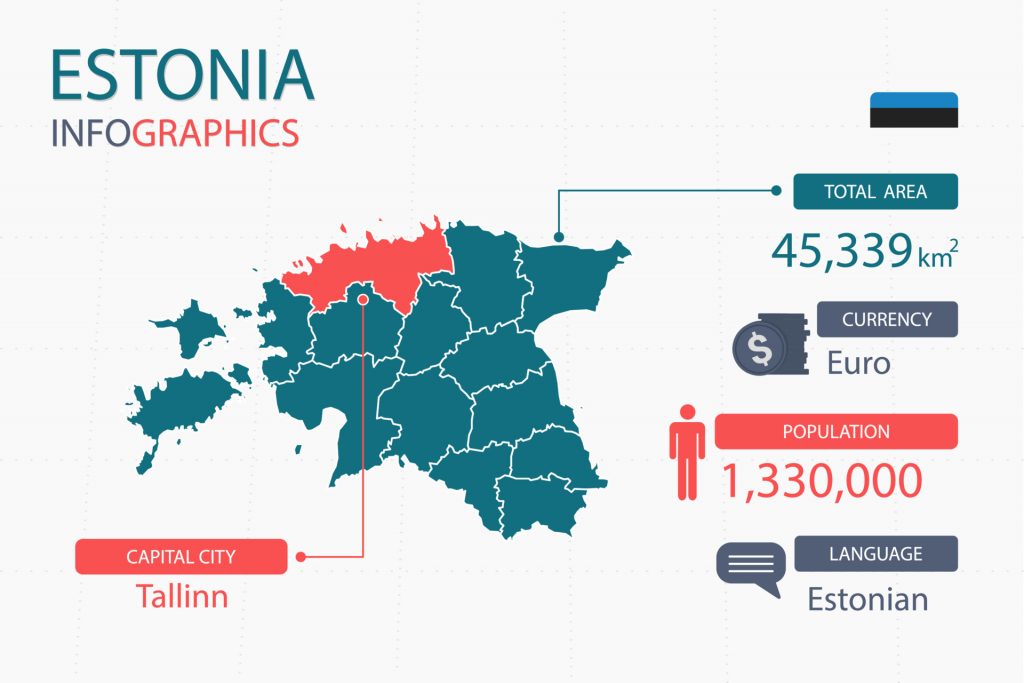The origins of the Estonian Language
Estonian is a language spoken by about one million people mostly in the country of Estonia, but in some areas outside of the country as well. It holds official status in Estonia as well as in the European Union. Estonian is considered a Finnic language. In fact, there are many similarities between Estonian and Finnish, another language in the same family. Many linguists consider these two to be partially mutually intelligible due to the characteristics that they share. Other languages in this language category include other less-known ones such as Karelian, Ingrian, and Veps.
Estonian can be classified as an agglutinative language; in these types of languages, affixes containing meaning combine together to convey more nuanced meanings. Its word order is similar to English, with a subject-verb-object order, but can be more flexible. It has been influenced in terms of grammar and vocabulary by a number of other languages throughout history. Hungarian, Swedish, and German have played a role due to historical contact between the languages. Specifically due to the German influence, English and Estonian share some common vocabulary that entered its core vocabulary base earlier in its historical development, instead of being a result of English globalization. Other influences include Russian and French.
Estonian is written using the Estonian alphabet derived from the Latin script. In addition to the standard letters, there are an additional six letters. These additional six are composed of one of the original standard sets with various accent marks on top of them. Some of the other letters are rarely used in Estonian, except for cases where certain foreign words or proper nouns of foreign origin are concerned. These letters include c, w, and x.

Modern Estonian has a unique history due to how Estonia was settled. Historians seem to agree that migration into Estonian territory occurred within two different prominent waves, with each wave originally speaking vastly different Finnic language varieties, presumably the precursor to modern-day Estonian. Two prominent groups settled in Estonia with one making home more in the North, and the other settling in the South. Thus, historically, North and South Estonian varieties did not evolve from one language but existed separately. Modern Estonian has its basis more on the Northern dialects, even though it draws influences from the Southern ones as well due to a common national identity nowadays.
The earliest records of the Finnic languages that preceded Modern Estonian can be traced back to the 13th century. In the 13th century, Estonian territories were conquered by Danish and German groups. Besides an Estonian grammar printed in German in 1637, not many other records of the language can be found until almost the 19th century, when more written records of Estonian became started to emerge, as the Age of Enlightenment promoted a cultural shift towards more intellectual values. During the late 18th and 19th century, scholars of Baltic German origin began promoting ancient Estonian culture, including its linguistic aspects. This period was called the Estophile Enlightenment Period, and during this time, Baltic Germans in Estonia adapted ideas, values, and the language of the Estonian natives. Estonian culture became one of extreme prestige, signifying status and education.
The Estonian language became the state language after the Estonian Liberation War in 1919, when Estonia became a newly formed and independent country shortly after World War I. During World War II, Estonia was again occupied, this time by the Soviet Union and both Russian and Estonia were considered the official languages. As a consequence, Russian influenced the development of Modern Estonian at this time. After 1991, Estonia was officially known as the Republic of Estonia and yet once again Estonian became the only official state language. Its use was widely promoted and the use of Russian was actually discouraged because of the Soviet Union’s history as occupiers. In addition, Soviet immigrants who moved into Estonia returned back to their home countries. Thus, those who considered themselves native Estonian were the majority group in the country, holding sway in terms of linguistic policies.
In Modern Estonian, linguists consider there to be two groups of dialects, similar to the language groups described above; a northern dialect group associated with the areas around Tallinn and the southern dialects that are prominent around Tartu in the south. The Southern Estonian dialects are sometimes quite different from Modern Estonian, so much so that some linguists consider them different languages, as the language communities also may have cultures that differ from the majority of Estonians, especially in terms of religion.
Estonian is now a language that represents a distinct identity and country and remains an important language in the world. Since the late 18th century, there has also been a body of literary work due to the prominence of Estophiles at that time. Such literary work has formed a basis for modern Estonian literature as well. In addition, aspects of Estonian culture have also made its way abroad, which help people become more aware of the language. For example, Estonian rock and metal music is quite popular, as well as certain Estonian films. In addition, there is an extensive history of literature and modern Estonian literature is still being produced, with crime novels being an especially popular genre. Notable popular Estonians include the charismatic Estonian footballer and coach, Mart Poom. The word ‘poom’ roughly translates as ‘explosion’ (‘boom’) in English which embodies Mart Poom’s dynamic personality.
All this has given Estonian an honorable place in the pantheon of world languages.
VEQTA can provide you with a perfect Estonian translator for your Estonian translation, English to Estonian translation and Estonian to english translation for the your targeted locale. Our translations to Estonian are created with your target audience in mind to meet your expectations.
If you need to translate Estonian – Get in touch today!
A dedicated team of Estonian translators who combines Experience, Specialized Subject Matter Expertise with best Translation Practices to deliver quality second to none.
Estonian Document Translation
Estonian Legal Translation
Estonian I.T Translation
Estonian Health & Fitness Translation
Estonian Medical Translation
Estonian Marketing Translation
Estonian Financial & Accounting Translation
Estonian Tourism & Travel Translation


